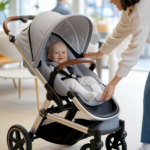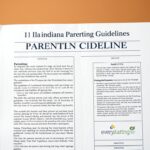Becoming a parent brings a new set of responsibilities and concerns, one of which is ensuring your baby is safe while traveling. For many parents, one of the first big decisions is selecting the right car that meets all the needs of a growing family. Whether you’re a first-time parent or expanding your family, finding the perfect baby car is no small task. You need to consider safety features, comfort, space, and, of course, budget. In this detailed guide, we will explore everything you need to know about choosing the best baby car and offer helpful tips to make your decision easier. So buckle up, and let’s dive into the world of baby-friendly cars!
Why the Right Baby Car is Crucial
As a parent, your priority is your baby’s well-being, especially when it comes to safety on the road. The car you choose will likely become your second home, whether it’s for everyday errands or road trips. Therefore, the importance of selecting a car that meets the specific needs of your family cannot be overstated. Here are a few reasons why the right baby car is essential:
- Safety: First and foremost, a family car should have top-tier safety features that protect your baby in case of accidents.
- Comfort: Long drives can be tough on babies, and the right car should offer a smooth ride and climate control to keep your little one comfortable.
- Space: A growing family means more stuff. Diaper bags, strollers, toys, snacks—you name it! A car with ample storage space and a roomy backseat is essential.
- Convenience: A family-friendly car should be equipped with features like easy-to-install car seats, accessible trunk space, and convenient technology.
Top Safety Features to Look for in a Baby Car
When selecting a car that’s suitable for your baby, safety should be at the top of your checklist. Automakers are constantly improving their safety features, and many cars now come equipped with state-of-the-art systems designed to keep all passengers safe. Here are some of the key safety features to look for:
1. Rearview Cameras and Parking Sensors
Backing up in a crowded parking lot or reversing out of your driveway can be challenging with a baby in the car. Rearview cameras give you a full view of what’s behind you, reducing the risk of accidents, especially in areas where children might be playing. Some cars also offer parking sensors that alert you when you’re getting too close to an object, making parking much safer and easier.
2. Side-Impact Airbags
While most cars come with front airbags, side-impact airbags are just as important, especially when your baby is sitting in the backseat. These airbags provide extra protection during side collisions, ensuring that all passengers, including your little one, are safeguarded from serious injuries.
3. Automatic Emergency Braking (AEB)
Automatic Emergency Braking is a lifesaving feature that helps prevent accidents by automatically applying the brakes if the car detects an imminent collision. This feature is especially helpful in situations where the driver might be distracted or unaware of a sudden stop in traffic.
4. LATCH System
The LATCH (Lower Anchors and Tethers for Children) system is a standardized way to install car seats without using seat belts. This makes it easier and safer to secure your baby’s car seat. When shopping for a car, ensure it has the LATCH system in place.
5. Blind Spot Monitoring
Blind-spot monitoring systems alert you if there’s a vehicle in your blind spot, making lane changes much safer. This is particularly useful when you have a baby in the backseat and your attention is divided.
For more information on car safety features, you can check out Safe Kids Worldwide, which provides excellent guidelines for selecting a safe family car.
The Best Car Seats for Your Baby
In addition to choosing the right car, you’ll need a top-quality car seat that ensures your baby’s safety and comfort. Car seats come in several different types, and each one is designed for a specific stage of your child’s life. Here’s a breakdown of the types of car seats you should consider:
1. Infant Car Seats
Infant car seats are designed for newborns and younger babies. These are rear-facing seats, which is the safest position for infants as it helps protect their fragile necks and spines during a crash. Most infant car seats can accommodate babies weighing between 4 to 35 pounds and come with carrying handles for easy transport in and out of the car.
2. Convertible Car Seats
A convertible car seat can be used in both rear-facing and forward-facing positions, making it a long-term investment as it grows with your child. Once your baby outgrows the infant car seat, you can switch to a convertible seat and continue using it for years. Many convertible car seats can accommodate children up to 65 pounds.
3. All-in-One Car Seats
All-in-one car seats offer a solution that will last your child through every stage, from infancy to early childhood. These seats can transition from rear-facing to forward-facing and even to a booster seat for older children. This versatility makes them a great option for parents who want a long-term solution.
4. Booster Seats
Booster seats are for older children who have outgrown their forward-facing car seats. These seats lift your child so that the seat belt fits them properly. Booster seats are recommended for children who weigh between 40 and 100 pounds, depending on the model.
You can learn more about car seat safety by visiting the NHTSA’s Child Car Seat Guidelines, which offer detailed recommendations based on your baby’s size and age.
Choosing the Right Car for Your Baby: Practical Considerations
While safety is the most important factor, there are several practical considerations to think about when choosing the right car for your family. Here’s what you need to know:
1. Space and Comfort
When you have a baby, space is key. You’ll need plenty of room for the car seat, your baby’s gear, and other passengers. Look for cars with spacious backseats and a roomy trunk. Larger vehicles like SUVs and minivans are popular choices for families because they offer the space you need for everything from strollers to groceries.
2. Trunk Space
In addition to interior space, your car should have a large enough trunk to fit baby gear like strollers, diaper bags, and even portable cribs. Hatchbacks and SUVs tend to offer more trunk space than sedans, making them more practical for parents with a lot of equipment to carry around.
3. Easy-to-Clean Interiors
Babies are messy, and your car will likely see its fair share of spills, crumbs, and accidents. Look for a car with easy-to-clean interior materials, such as leather or high-quality fabric that can withstand frequent cleaning.
4. Climate Control
Your baby’s comfort is essential, and climate control is a feature that can make a big difference. Ensure the car has a good air conditioning system that reaches the backseat, where your baby will be sitting. Some larger family vehicles even offer rear-seat climate control, allowing you to adjust the temperature for your little one.
5. Technology Features
Modern family cars often come equipped with technology that can make driving with a baby much easier. Here are a few tech features that parents love:
- Built-in Screens: These can entertain older children during long trips by playing movies or educational videos.
- Bluetooth Connectivity: This allows you to connect your phone and play your baby’s favorite lullabies or soothing music through the car’s speakers.
- USB Charging Ports: Handy for keeping devices charged, especially if you’re using a tablet for baby monitoring or entertainment during long drives.
Budget-Friendly Baby Car Options
Not every parent can afford a luxury SUV, but there are plenty of affordable cars that offer excellent safety and comfort features. Here are some of the best budget-friendly baby cars that won’t break the bank:
1. Honda CR-V
The Honda CR-V is a popular choice among families for its reliability, safety features, and fuel efficiency. It’s also spacious, with plenty of room in the backseat for a car seat and in the trunk for baby gear.
2. Toyota RAV4
Another compact SUV that offers a great balance of affordability and functionality is the Toyota RAV4. It has high safety ratings and comes equipped with many standard safety features, making it an excellent choice for new parents.
3. Subaru Outback
The Subaru Outback is known for its all-wheel-drive capabilities, making it a great option for families living in areas with harsh weather conditions. It also offers a smooth ride, lots of trunk space, and great fuel economy.
4. Kia Sorento
The Kia Sorento is a midsize SUV that offers plenty of space for families without being too bulky. It also has an excellent warranty, making it a cost-effective option for parents looking for long-term reliability.
For more information on affordable family-friendly cars, you can visit Edmunds, which offers reviews and pricing guides on a wide range of vehicles.
The Importance of Test Driving Your Baby Car
Before making your final decision, it’s crucial to take your potential baby car for a test drive. This allows you to see how the car handles, test the comfort levels, and ensure that it meets all your requirements. Here are a few things to consider during your test drive:
- Ease of Installing the Car Seat: Bring your baby’s car seat with you and see how easy it is to install in the car.
- Driving Comfort: Consider how smooth the ride is and whether the car handles well on different road surfaces.
- Noise Levels: Babies can be sensitive to loud noises, so make sure the car offers a quiet ride.
Final Thoughts: Finding the Perfect Baby Car
Choosing the right baby car is a big decision, but it doesn’t have to be overwhelming. By focusing on safety, comfort, and practicality, you can find a car that suits your family’s needs. Whether you’re looking for a spacious SUV or a budget-friendly sedan, there’s a baby-friendly car out there for every parent.
For more parenting tips and product reviews, check out the related articles on our blog, like:
- How to Choose the Best Car Seat for Your Baby
- Creating a Safe Sleep Environment for Your Baby
- Essential Baby Gear for New Parents
And don’t forget to check out external resources like Safe Kids Worldwide and NHTSA’s Child Car Seat Guidelines for more expert advice on baby car safety.
Happy driving, and safe travels with your little one!














